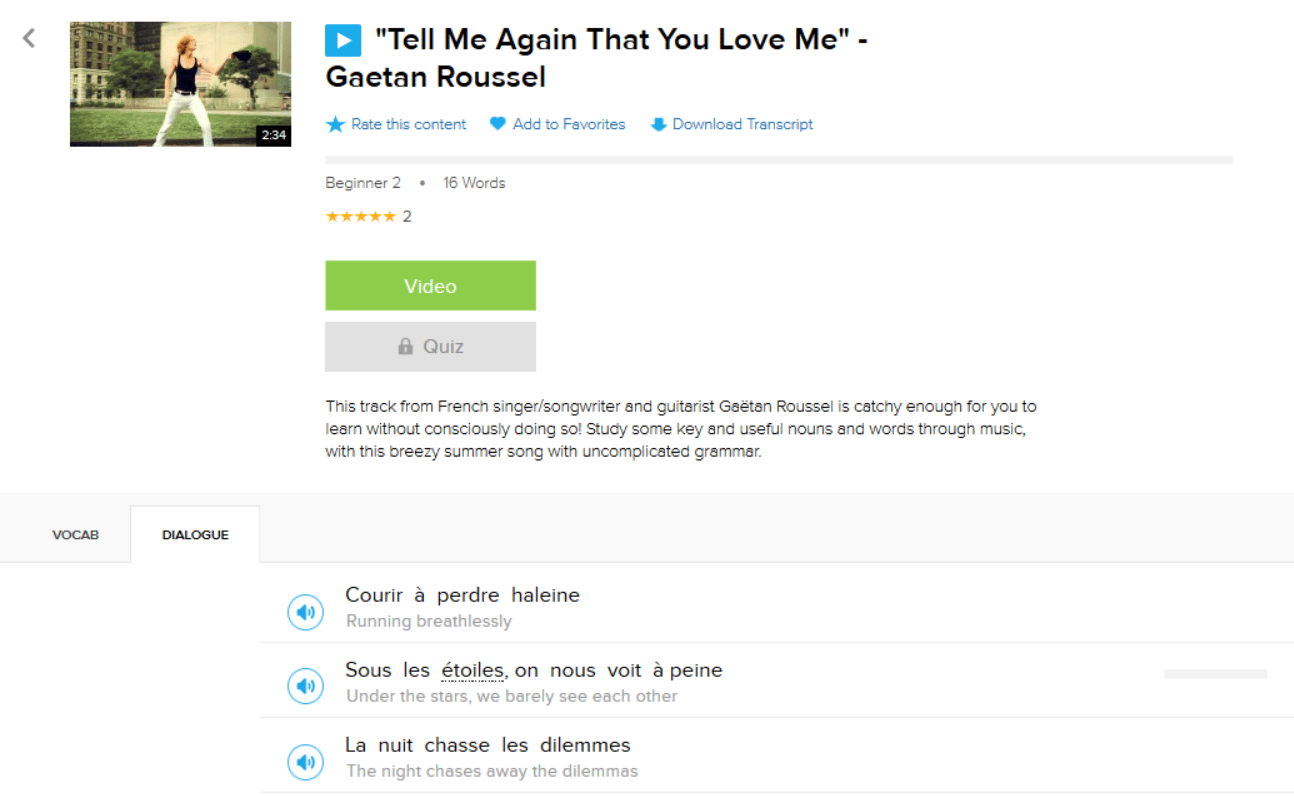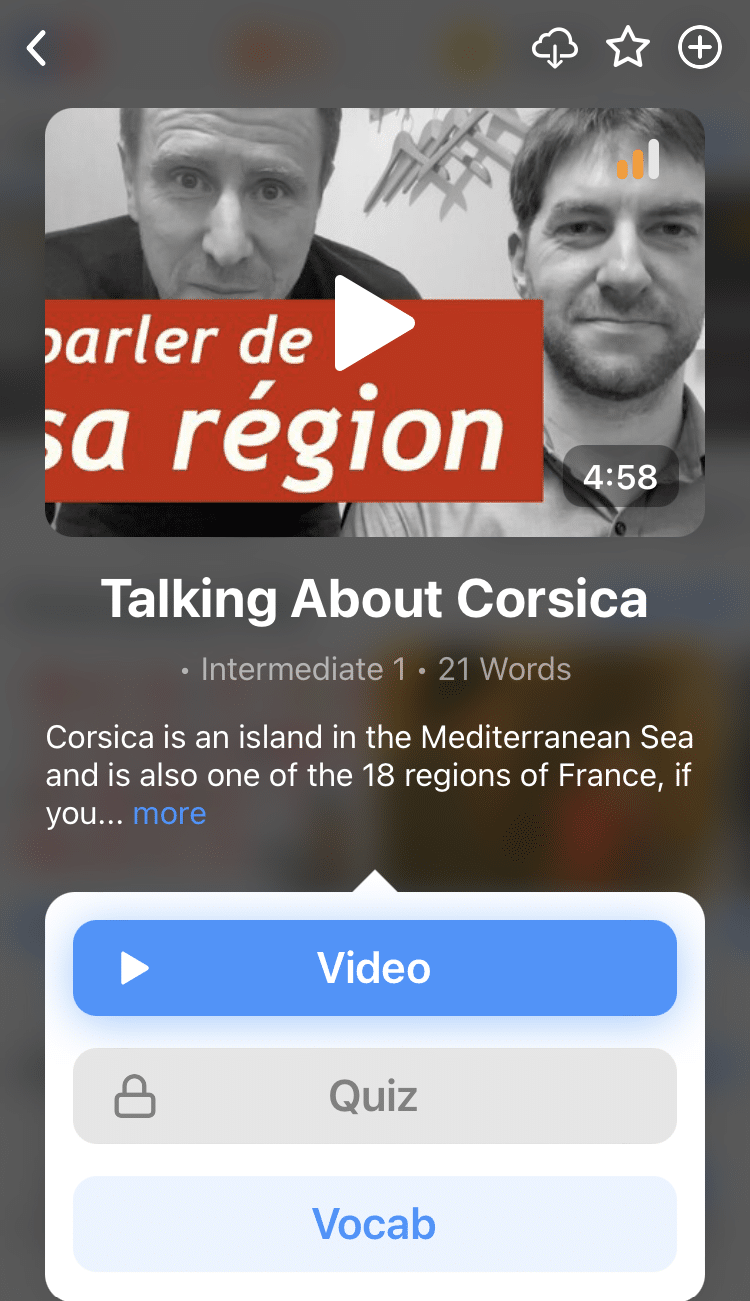Contents
- 1. -able
- 2. -age
- 3. -ain(e)/-ais(e)/-ois(e)/-éen(e)
- 4. –aire
- 5. -al/-ale
- 6. -ance
- 7. -ant/-ante
- 8. -ateur/-atrice
- 9. -eau/-elle
- 10. -é
- 11. -ée
- 12. -erie
- 13. -esse
- 14. -et/-ette
- 15. -eur/-eresse
- 16. -if/-ve
- 17. -isme
- 18. -issime
- 19. -iste
- 20. -ite
- 21. -tion, -ation, -ition
- Where to Practice French Suffixes
- And one more thing...
21 Common French Suffixes (and How They’ll Expand Your Vocab)

Suffixes can transform your French vocabulary. Specifically, they allow you to quickly acquire new words based on your existing vocabulary, since French suffixes are added to nouns, verbs and adjectives. They’re also great for brevity. For example, it’s much less of a mouthful to say une poissonnerie (a fish market) than un endroit où se trouve du poisson en vente (a place where one finds fish for sale).
Because suffixes in French are derived from Latin or Greek like their English counterparts, many French and English suffixes are the same (except for minor variations in spelling). Basically, your French reading comprehension and writing will quickly improve once you learn more suffixes.
Download: This blog post is available as a convenient and portable PDF that you can take anywhere. Click here to get a copy. (Download)
1. -able
Type of suffix: adjectival (i.e., the suffix turns words into adjectives)
Gender: neutral
Use: can only be added to verbal stems—that is, verbs minus their -er, -ir or -re endings. Denotes the possibility or ability to be done.
Example:
laver (wash) + -able → lavable (washable)
Cette chemise est lavable à l’eau chaude. (This shirt can be washed in hot water.)
2. -age
Type of suffix: nominal (i.e., the suffix turns words into nouns)
Gender: masculine
Use: refers to the “action or result of X-ing” or the “state of being a(n) X”
Example:
esclave (slave) + -age → esclavage (the state of being a slave or, more succinctly, slavery)
L’esclavage est horrible. (Slavery is horrible.)
3. -ain(e)/-ais(e)/-ois(e)/-éen(e)
Type of suffix: nominal or adjectival
Gender: adding e to the suffix makes it feminine
Use: describes someone or something by their place of origin (i.e., a diminutive noun)
Examples:
A person, place or thing from la Jamaïque (Jamaica) is jamaïcain / jamaïcaine (Jamaican).
Il y a un nouveau restaurant jamaïcain dans le quartier. (There is a new Jamaican restaurant in the neighborhood.)
Note: Jamaïcain can also be spelled as jamaïquain , although this spelling isn’t as popular.
A person, place or thing from la France (France) is français / française (French).
Sa femme est française. (His wife is French.)
J’ai une voiture française. (I have a French car.)
A person, place or thing from le Danemark (Denmark) is danois / danoise (Danish).
A person, place or thing from l’Europe (Europe) is européen / européene (European).
4. –aire
Type of suffix: nominal
Gender: neutral
Use: added to words to convey a relationship or connection to the base word (e.g., profession, quality or characteristic)
Example:
volonté (drive or will) + -aire → volontaire (voluntary)
Elle est volontaire ici depuis deux ans. (She’s been a volunteer here for two years.)
5. -al/-ale
Type of suffix: adjectival
Gender: -al is masculine, while -ale is feminine
Use: indicates a relationship or characteristic shared with the root word
Example:
nation (nation) + -ale → nationale (national)
C’est une compétition nationale. (It’s a national competition.)
6. -ance
Type of suffix: nominal
Gender: feminine
Use: indicates a state, quality or action
Example:
ignorer (ignore) + -ance → ignorance (ignorance)
L’ignorance n’est pas une excuse. (Ignorance is not an excuse.)
7. -ant/-ante
Type of suffix: verbal (i.e., forms a verb) and adjectival
Gender: -ant is masculine, while -ante is feminine
Use: forms present participle verbs and adjectives
Example:
étudier (study) + -ant → étudiant (student)
Je suis étudiant. (I am a student.)
8. -ateur/-atrice
Type of suffix: nominal or adjectival
Gender: -ateur is masculine, while -atrice is feminine
Use: signifies actors or agents
Examples:
dévaster (devastate) + -ateur → dévastateur (something that devastates or is devastating, as in un ouragan dévastateur or “a devastating hurricane”)
Elle a une maladie dévastatrice. (She has a devastating illness.)
ventiler (ventilate) + -ateur → ventilateur (a fan)
J’ai besoin d’un ventilateur pour cette pièce. (I need a fan for this room.)
Note: In this word, we see the word vent (wind), which is a nice addition to your weather-related French vocabulary.
9. -eau/-elle
Type of suffix: nominal
Gender: -eau is masculine, while -elle is feminine
Use: has a diminutive function
Examples:
Un petit lapin (a little rabbit, as in a young one) can be condensed to un lapineau (a little rabbit).
Le lapineau a perdu sa mère. (The young rabbit lost its mother.)
Une petite rue (a little street) can be shortened to une ruelle (a little street or alley).
J’ai entendu un hurlement dans une ruelle. (I heard a scream in an alley.)
10. -é
Type of suffix: nominal, verbal or adjectival
Gender: neutral
As a suffix, this acute accent can perform many roles, such as:
Forming the past participle
This suffix is used to construct the past participle of -er verbs, where -é replaces the -er.
The past participle of manger (eat) is mangé (ate).
J’ai mangé tard. (I ate late.)
La viande, mangée par les mouches, est dans la poubelle. (The meat, eaten by the flies, is in the trash.)
Forming adjectives
If the root is a noun, the suffix -é can be added to produce an adjective that signifies “possessing X” or “resembling X.”
Le sens refers to sense (as in common sense) or reason, so the adjective sensé refers to something or someone reasonable or possessing sense/reason.
Ses propos sont sensés. (His remarks are reasonable.)
Forming nouns
The suffix -é can be added to nouns to denote “the state of X.”
In French, un parent denotes not only a mother or a father, but a relative in general. La parenté refers to kinship, (family) relationship or relatedness.
Quel est ton lien de parenté avec elle ? (What is your relationship to her?)
11. -ée
Type of suffix: nominal
Gender: neutral
This multipurpose suffix can be added to nouns or verbs to make new nouns with different meanings.
“A __ful of” something:
Une poignée (a fistful) derives from un poing (a fist).
J’ai mangé une poignée de dates ce matin. (I ate a fistful of dates this morning.)
Result of an action, purpose:
Une donnée (a piece of data or information) comes from the verb donner (give).
La société stocke ses données sur un serveur. (The company keeps its data on a server.)
A location:
Une entrée (an entrance) derives from the verb entrer (enter).
L’entrée du bâtiment est ouverte. (The building’s entrance is open.)
Period of time:
Une matinée (the morning hours) comes from le matin (the morning).
J’ai lu toute la matinée. (I read all morning.)
12. -erie
Type of suffix: nominal
Gender: feminine
Use: denotes “a specialty in X.” In many cases, it also denotes “a place that sells X.”
Examples:
Une poissonnerie (a fish market) is a place that specializes in or sells du poisson (fish).
J’ai acheté ce flet dans une poissonnerie. (I bought this flounder at the fish market.)
Une bijouterie (a jewelry store) is a place that specializes in or sells des bijoux (jewelry).
Jean a acheté un cadeau pour sa femme dans une bijouterie. (Jean bought a present for his wife at a jewelry store.)
13. -esse
Type of suffix: nominal
Gender: feminine
Use: indicates a quality or state of being
Example:
jeune (young) + -esse → jeunesse (youth; young people)
La jeunesse a des problèmes. (The youth have problems.)
14. -et/-ette
Type of suffix: nominal
Gender: -et is masculine, while -ette is feminine
Use: has a diminutive function, making the noun smaller. Think of this suffix as synonymous with un petit X (a little X).
Examples:
Un petit garçon (a little boy) can also be referred to as un garçonnet (a little boy).
Le garçonnet court après le ballon. (The little boy is running after the ball.)
Une petite fille (a little girl) can also be referred to as une fillette (a little girl).
La fillette porte une robe jaune. (The little girl is wearing a yellow dress.)
15. -eur/-eresse
Type of suffix: nominal
Gender: -eur is masculine, while -eresse is feminine
Use: indicates a person or thing that performs a specific action
Example:
agir (act) + -eur → acteur (actor)
Joe est un mauvais acteur. (Joe is a bad actor.)
16. -if/-ve
Type of suffix: adjectival
Gender: neutral
Use: turns a noun into an adjective that embodies the noun’s characteristics
Example:
créer (create) + -if → créatif (creative)
C’est un motif très créatif. (It is a very creative design.)
17. -isme
Type of suffix: nominal
Gender: masculine
Use: refers to doctrines, ideologies or belief systems. It’s added to adjectival stems that often end in -iste.
Examples:
Une doctrine nationaliste (a nationalist doctrine) can be condensed to nationalisme (nationalism).
Le nationalisme est en pleine croissance en France. (Nationalism is spreading quickly in France.)
Une doctrine socialiste (a socialist doctrine) can be shortened to socialisme (socialism).
Le socialisme est un système politique et économique. (Socialism is a political and economic system.)
18. -issime
Type of suffix: adjectival
Gender: neutral
Use: has an augmentative function, making the adjective stronger. Think of -issime as synonymous with the adjectives très (very) and extrêmement (extremely).
Examples:
Très grand (very big) can be simply put as grandissime (very big).
La maison du Charles est grandissime. (Charles’ house is very big.)
Très grave (very serious) can be shortened to gravissime (very serious).
La maladie est gravissime. (The illness is very serious.)
19. -iste
Type of suffix: nominal
Gender: neutral
Use: refers to nouns that conform to certain doctrines or schools of thought
Example:
Someone or something (e.g., a book) that adheres to the doctrine of fascisme (fascism) is fasciste (fascist).
Le gouvernement de Benito Mussolini était fasciste. (Benito Mussolini’s government was fascist.)
20. -ite
Type of suffix: nominal
Gender: neutral
Use: indicates that a noun takes on a certain quality. If applied to a person, it can denote a follower of a certain belief or religion.
Examples:
curieux (curious) + -ite → curiosité (curiosity)
Sa curiosité est sans fin. (His curiosity is without end.)
bouddhisme (Buddhism) + -ite → bouddhiste (Buddhist)
J’ai toujours voulu être bouddhiste. (I have always wanted to be a Buddhist.)
21. -tion, -ation, -ition
Type of suffix: nominal
Gender: feminine
Use: indicates an action, process or state
Example:
traduire (translate) + -tion → traduction (translation)
J’ai terminé la traduction. (I finished the translation.)
Now that you’ve seen some of the more common suffixes in French, you can take things to the next level by exposing yourself to authentic French media on a language learning platform like FluentU.
FluentU takes authentic videos—like music videos, movie trailers, news and inspiring talks—and turns them into personalized language learning lessons.
You can try FluentU for free for 2 weeks. Check out the website or download the iOS app or Android app.
P.S. Click here to take advantage of our current sale! (Expires at the end of this month.)
Where to Practice French Suffixes
Below are some resources on French suffixes that will keep you ahead in the vocabulary game.
- The Francophone sites Orbilat and Études littéraires both have reference guides to an extensive list of suffixes—complete with examples!
- Once you’re ready to get your feet wet and really start testing out your knowledge, “French Vocabulary Building with Prefixes and Suffixes” by Eliane Kurbegov is chock-full of vocabulary-building exercises. It comes with a neat flashcard app to boot, so you can practice suffixes and prefixes when you’re on the move.
And that’s just the beginning. Now, it’s up to you to stay ahead!
Download: This blog post is available as a convenient and portable PDF that you can take anywhere. Click here to get a copy. (Download)
And one more thing...
If you like learning French vocabulary on your own time and from the comfort of your smart device, then I'd be remiss to not tell you about FluentU.
Other sites use scripted content. FluentU uses a natural approach that helps you ease into the French language and culture over time. You’ll learn French as it’s actually spoken by real people.
FluentU has a wide variety of great content, like interviews and web series, as you can see here:

FluentU brings native videos within reach with interactive subtitles.
You can tap on any word to look it up instantly. Every definition has examples that have been written to help you understand how the word is used.

For example, if you tap on the word "crois," you'll see this:

Practice and reinforce all the vocabulary you've learned in a given video with FluentU's adaptive quizzes. Swipe left or right to see more examples for the word you’re learning and play the mini-games found in the dynamic flashcards, like "fill in the blank."

As you study, FluentU tracks the vocabulary that you’re learning and uses this information to give you a 100% personalized experience.
It gives you extra practice with difficult words—and reminds you when it’s time to review what you’ve learned.
Start using the FluentU website on your computer or tablet or, better yet, download the FluentU app from the iTunes or Google Play store. Click here to take advantage of our current sale! (Expires at the end of this month.)








